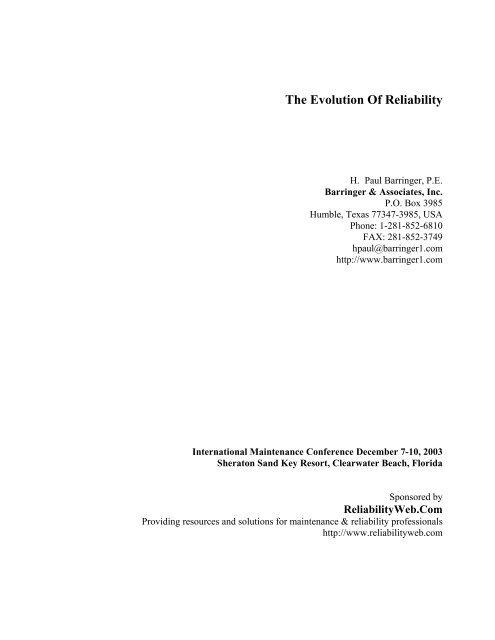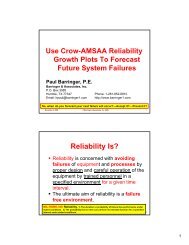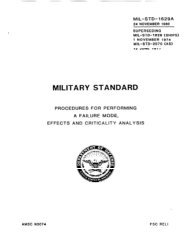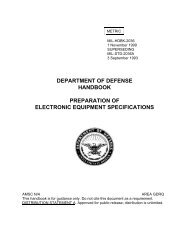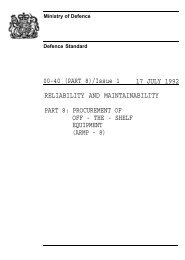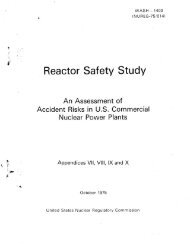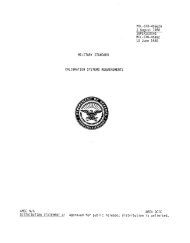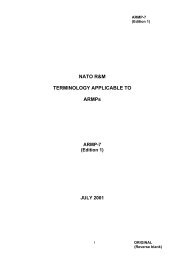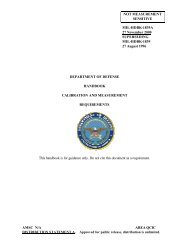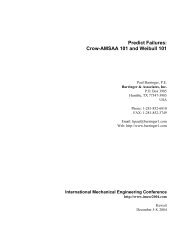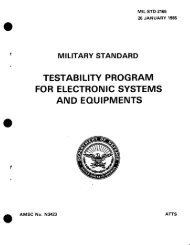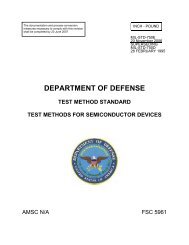The Evolution Of Reliability - Barringer and Associates, Inc.
The Evolution Of Reliability - Barringer and Associates, Inc.
The Evolution Of Reliability - Barringer and Associates, Inc.
You also want an ePaper? Increase the reach of your titles
YUMPU automatically turns print PDFs into web optimized ePapers that Google loves.
<strong>The</strong> <strong>Evolution</strong> <strong>Of</strong> <strong>Reliability</strong>H. Paul <strong>Barringer</strong>, P.E.<strong>Barringer</strong> & <strong>Associates</strong>, <strong>Inc</strong>.P.O. Box 3985Humble, Texas 77347-3985, USAPhone: 1-281-852-6810FAX: 281-852-3749hpaul@barringer1.comhttp://www.barringer1.comInternational Maintenance Conference December 7-10, 2003Sheraton S<strong>and</strong> Key Resort, Clearwater Beach, FloridaSponsored by<strong>Reliability</strong>Web.ComProviding resources <strong>and</strong> solutions for maintenance & reliability professionalshttp://www.reliabilityweb.com2003
<strong>The</strong> <strong>Evolution</strong> of <strong>Reliability</strong>H. Paul <strong>Barringer</strong>, P.E.<strong>Barringer</strong> & <strong>Associates</strong>, <strong>Inc</strong>.,SUMMARY: Key issues describe how to put reliability into equipment <strong>and</strong> processes based on personalexperiences. <strong>The</strong> steps along the way include both hardware <strong>and</strong> people so that we simply operate forreliability. A path for progress outlines how to ensure reliability considerations along with alternatives for thecost of unreliability driven by the concept for a reliability policy.Keywords: cost of unreliability, reliability, reliability alternatives, reliability policy1. WHAT IS RELIABILITY?Long life without failure is the simple definition of reliability. <strong>Reliability</strong> always terminates in a failure. <strong>Of</strong>course, you must observe practical limitations to obtain long life without failure. It is easy to kill people,equipment <strong>and</strong> processes. It is difficult to make things survive for a long time. Most people, equipment, <strong>and</strong>processes have distinct periods of life, for example, people rarely live longer than 115 years when a birthcertificate <strong>and</strong> death certificate exist. Most things have a distinct range of life for survival. For a reliabilitydefinition, you need to define failures—a simple definition of failure is loss of function when you needed it.Formal reliability definitions may include “<strong>Reliability</strong> is the probability that a device, a system, orprocess will perform its prescribed duty without failure for a given time when operated correctly in aspecified environment.” This complicated reliability definition involves:• probability (chances) for survival [absence of absolute statements about survival]• components, systems, <strong>and</strong> processes [the issue is complex--not simple]• functioning without failure [reliability (survival) terminates in a failure (death)]• function for a given time period [state the elapsed time expected--nothing survives forever]• duty cycles under the concept of prescribed duty [design for the cycle peaks—not the “average”]• correct operation is a key element for survival [you must know right from wrong]• design for use in the correct environment [successes in one environment is failure for another]Designing reliability into the component, system, or process is the best practice. Designing for reliabilitymeans you must be able to specify the details. If you do not know what you want, how will you ever knowif you get it? If you cannot specify what you want, you will be stuck in a take what you get environment <strong>and</strong>that usually involves high cost <strong>and</strong> much suffering.If you have inherited equipment with low reliability, many failures, you may need improvements to gaincompetitive advantage. Improvements will cost money. Failures cost money. Expenditures forimprovements are trade-offs against the cost of unreliability (COUR). COUR is a pool of money for fundingimprovements but you must do the calculations. You must have a path forward to a successfully achievereliability?Page 2 of 10 <strong>The</strong> <strong>Evolution</strong> of <strong>Reliability</strong> IMC-2003
2. A PATH FORWARD FOR RELIABILITYTo be rich <strong>and</strong> h<strong>and</strong>some/beautiful is easier to accomplish if you are born to rich, attractive parents. If youdid not choose your parents wisely, you know your life is going to be more difficult!I was very fortunate in my choice of “parents” for reliability. We did not speak the word reliability veryoften but we lived the reliability culture at every turn with “always safe practices for long life”.In 1960, I worked at Union Carbide’s 5,000 acre Oak Ridge Gaseous Diffusion Plant also known by its gridlocations known as K-25. This was the world’s largest physio-chemical process.• This single purpose plant separated the U 235 isotope from the naturally occurring mixture.• <strong>The</strong> plant was huge--the original WWII building was 1KM per side.• <strong>The</strong> plant contained vast quantities of a very aggressive corrosive/toxic fluorine as the carrier gas.• <strong>The</strong> feed stream gas carried a heavy metal, uranium that is harmful to living things.• <strong>The</strong> product isotope has a 0.5% concentration in yellow cake feed stock <strong>and</strong> must be concentrated to~3.5% for nuclear reactors or ~95%+ for weapons so this introduces radiological problems as theexpensive product is concentrated.• <strong>The</strong> process equipment involves huge centrifugal <strong>and</strong> axial flow compressors placing enormouselectrical dem<strong>and</strong>s on 5 or 6 TVA power plants making the process unbelievably expensive.• <strong>The</strong> diffusion process used a probabilistic method involving porous nickel barrier with repetitivepasses through a cascade--it played the odds for separating U 235 from the mixture of U 235 +U 238 .I started working in the K-25 plant Mechanical Development Department on an ultracentrifuge developedby Dr. Zippe, a German retained in Russia <strong>and</strong> repatriated ~1955. <strong>The</strong> Zippe centrifuge had a designspeed of 90,000 rpm (1500 revolution/second). Our task was to start with the 90,000 RPM centrifuge <strong>and</strong>then build faster/better centrifuges. <strong>The</strong> centrifuge pilot plant had a development objective to put a lessexpensive isotope separation plant into operation to beat the cost of the expensive gaseous diffusionprocess. Putting ultra high-speed equipment into the isotope separation equation was not simple. Highspeed rotating equipment requires that everything must be done just so to achieve long life <strong>and</strong> fewfailures (i.e., reliability) when working with uranium hexafluoride!My coach <strong>and</strong> mentor at K-25 was Edwin Babely. Ed Babely was a thoughtful, clever, wise, savvy, <strong>and</strong>patient engineer. He carefully taught me right from wrong about process gasses, ultra high vacuum systems,“always safe processes”, <strong>and</strong> a “million” details in his daily drills. Babely excelled in a plant full of supertechies <strong>and</strong> was named Union Carbide’s Engineer of the Year for his excellence in mentoring <strong>and</strong> technicalcapabilities.Babely’s mentoring was in the form of daily coaching, asking questions that I had to research, requiringme to make detailed calculations to explain our mutual hypothesis, introducing me to the supertechnologist who were experts in chemistry, physics, metallurgy, mathematicians, main frame computerspecialists, <strong>and</strong> top management (yes, he made sure I had exposure to the top brass). His dem<strong>and</strong>s were:Page 3 of 10 <strong>The</strong> <strong>Evolution</strong> of <strong>Reliability</strong> IMC-2003
• Read (Study magazines <strong>and</strong> technical books including the Manhattan Project book on the separativeefficiency of gaseous diffusion cascades written by 1934 Nobel Laureate Harold Urey.)• Ask the experts (Work their numbers to underst<strong>and</strong> how <strong>and</strong> why they got from A to B. Talk tothem, you’ll learn something every time.)• Study (Learning is a full time, never ending exercise. If you’re not learning, you’re regressing.)• Talk (Discuss problems, solutions, <strong>and</strong> examine all the corners <strong>and</strong> back alleys of issues.)• Hurry (Tempus fugits! You don’t have time for perfect solutions—hurry, move on!)• Gain experience--experiment (Start with a good hypothesis, test it, revise it, <strong>and</strong> solve problemsto gain experience very quickly. <strong>The</strong> more you learn the more you grow if you benefit from yourmistakes, which forms your lessons learned library. Let experiments improve your calculations.Use your hypothesis <strong>and</strong> be competitive—someone else always has a competitive hypothesis soyou need to learn fast to keep from eating dust.)• Money (Good engineering without funding <strong>and</strong> without adding value is a waster of time/effort.)• Keep management informed (You do not live in a vacuum. Update management frequently—but you had better have something useful to report, which means you need physical progress.)With this agenda, we moved forward developing reliable rotating equipment for isotope separation thatwould run unattended for long periods without attention or intervention.<strong>The</strong> gas centrifuge effort branched to solve a biological centrifuge reliability problem. Dr. Norman G.Anderson, of the Oak Ridge National Laboratory Biology Division, had biological centrifuges from avendor that could not reliably operate at their design speed of 40,000 RPM. Dr. Anderson needed thecentrifuges for continuous flow separation of viruses on a large scale.From lessons learned with gaseous centrifuges, we quickly had biological centrifuges operating at ratedspeeds for long run, large batch size separation of viruses in zonal ultra centrifuges. Under NationalInstitutes of Health funding, we installed other zonal ultracentrifuges into production lines at Eli Lilly <strong>and</strong>Pfizer to separate influenza (flu) vaccines. Zonal ultracentrifuges have a density gradient across theradius of the centrifuge. Viruses, under a centrifugal field move radially outward until they match theirdensity to the fluid density. Virus concentration occurs in thin annular zones within the centrifuge.Today, every time you get a flu shot, you can say thanks to Dr. Anderson for his separation technology<strong>and</strong> to the mechanical team of <strong>Barringer</strong> <strong>and</strong> Babely for solving the reliability problems, which made thebiological technology possible. We solved mechanical problems that made zonal ultracentrifuges runreliably at 40,000 RPM (it was a rotor dynamics/damping problem) for producing flu vaccines that do nothurt your arm <strong>and</strong> give a very sore goose egg sized bump after the inoculation [for those of you receivingflue injections after 1970—you have no clue about the previous problems].Seldom do biologists have engineers on their development teams. When they do, the merging of twodifferent technology streams resulted in synergy for unique hardware (141,000 RPM centrifuges) alongwith new biological techniques for large scale separations. In the biological/medical/isotope fields, youmust do things correctly every time. Otherwise, you may not personally get a second chance if you lackreliability!—<strong>and</strong> reliability must be demonstrated for long periods with biological centrifuges filled withvirus that cause/prevent diseases.Page 4 of 10 <strong>The</strong> <strong>Evolution</strong> of <strong>Reliability</strong> IMC-2003
We had high-speed centrifuge bearings that were OK, but you always need better bearings. We made ourtrip to visit with the German expatriate missile teams at the Redstone Arsenal to learn about their highspeedgyro bearing systems <strong>and</strong> to get a quick spin-up in reliability issues.However, we missed a singularly important issue in our discussions with the German technologists: Wedid not make the new vocabulary speak to us in clear, definitive, <strong>and</strong> action oriented terms attached to themath. We talked about reliability but we did not underst<strong>and</strong> how to make the reliability technology workfor us. We heard the words but we did not see the quantification path for success—we were probably toobusy to see the trees for the forest <strong>and</strong> the trees were our obstacle.We were reliability dwarfs. We did not leverage the German reliability technology in a cumulative manner.We could have seen <strong>and</strong> achieved more by st<strong>and</strong>ing on the shoulders of the German technology giants withwhom we were speaking. We failed to comprehend the language of the missile experts. We failed to converttheir information into language of mathematics. We heard them but we did not fully underst<strong>and</strong>. We misseda big opportunity! You must underst<strong>and</strong> technology by both words <strong>and</strong> numbers or you will never growbeyond the dwarf stage.Isaac Newton (b. Christmas 1642, d. March 19, 1727) clearly illustrates the language <strong>and</strong> math problem hefaced explaining motion (Gleick 2003, p 43, 45, 58, 96, 188)—“He was hampered by the chaos of language—words still vaguely defined <strong>and</strong> words not quite existing”. <strong>The</strong> culture of Newton’s late 1600s lackedtechnology for time, speed, acceleration, mass, <strong>and</strong> gravity.Newton had to invent words to communicate his math with words such as velocity, a mid 16 th century word,(at that time the idea of speed was a sailors term based on throwing a log overboard <strong>and</strong> watching how fast theknots in the line passed). Issues such as rate of change required velocity <strong>and</strong> position, then came the problemof acceleration—how can you explain the rate of change based on another rate of change? How can youexplain mass where the root of Newton’s word meant “barley cake”? How can you explain gravity, whichstems from a 15 th century word for heaviness? How can you measure force, a 13 th century word meaningstrong <strong>and</strong> what units will you use for measuring force? How do you define the word centrifugal <strong>and</strong>centripetal, an early 18 th century word describing, “seeking the center”? How do you connect thecentrifugal/centripetal concept to the motion of planets <strong>and</strong> comets when no one can physically see a physicalconnection that explains their motion across a 13 th century word called space? How can you explain theconcept of something so small that it’s slightly larger than zero by use of the mid to late 17 th century wordinfinitesimal to describe Newton’s concept of calculus?To underst<strong>and</strong> motion, Newton had to first invent the math. <strong>The</strong>n Newton had to invent the words toexpress the math. Many of Newton’s contemporaries had three strong views of his work on motion:1. It’s too hard to underst<strong>and</strong>! All that math! All those new words! “…lack of a vocabulary hinderedthe effort” <strong>and</strong> Newton “…needed a foundation of words that did not exist in any language”,2. Newton’s work has no practical purposes—it’s the stuff of clever dreams, <strong>and</strong>3. <strong>The</strong> rat! He stole the idea from me.“What Newton learned entered the marrow of what we know without knowing how we know it.”So what is the point of this Newton language discussion? You must underst<strong>and</strong> the language, which requiresyou study the subject. Convert language into mathematical expressions so it becomes a working concept. Ifyou do not underst<strong>and</strong> both the language <strong>and</strong> the math, you will fail to comprehend the issues.Comprehension failures mean missed opportunities.Page 5 of 10 <strong>The</strong> <strong>Evolution</strong> of <strong>Reliability</strong> IMC-2003
Ben Koff, a leading designer of gas turbines for General Electric <strong>and</strong> Pratt & Whitney describes missedopportunities for a great aircraft propulsion technology advance in this way (Koff 2003):“<strong>The</strong> Americans got a late start in the development of the gas turbine engine becauseresponsible leaders didn’t believe the gas generator cycle consisting of a compressor,combustor <strong>and</strong> turbine was practical. <strong>The</strong> reasoning was that after the power was extractedfrom the turbine to drive the compressor, there wouldn’t be enough residual energy in theexhaust gas for useful work”.Key experiments <strong>and</strong> calculations [we simply did not underst<strong>and</strong> <strong>and</strong> we did not get our numbers together] weremissing from American decisions about jet engines. This persisted after the English inventor of a gas turbineengine, Whittle, came to the States to teach Americans’ how to build the engine <strong>and</strong> two engines manufacturedby General Electric powered the Bell XP-59A in jet flight in 1942. <strong>The</strong> USA had no combat jet fighters inWWII. We learned important lessons about gas turbine engines the hard way in mortal combat against superiorweapons in WWII. Abernethy (Abernethy 2003a) reports early German jet engines had obvious reliabilityproblems:“… the original German Jumo gas turbine engines for the Messerschmitt Me 262 jet fighterhad a mean time of 25 hours/failure for in-flight shutdowns. This short life was acceptable asthe Me 262 had an average combat life of 7 hours <strong>and</strong> 10 minutes (Abernethy 2003b).Contrast early German gas turbine engines 25 hour/failure to today’s average of 25,000hours/failure (in-flight shutdowns) for reliable modern jet engines on commercial aircraft.”Language problems existed for early gas turbines. Language problems still exist today in other industrialareas. For example, some people think availability <strong>and</strong> reliability are the same word. Failure tounderst<strong>and</strong> the difference that availability ≠ reliability sends organizations to work on the wrongproblems.• Availability tells how you are using time. In simple form, Availability = (uptime)/(uptime + downtime). We have 8760 hours in a typical year--we know the denominator. If the uptime is 7884hrs/year, then availability = 7884/8760 = 90%. This says 90% of the time we are alive <strong>and</strong> ready todo the assigned task. Management is often happy about the percent availability <strong>and</strong> do not work onthe number of failures causing down time (failures drive waste <strong>and</strong> loss of productive effort).• <strong>Reliability</strong> tells the probability for a failure free interval. In simple form, <strong>Reliability</strong> = e − Nwhere N = number of failures expected during the mission period. Suppose we set a mission timeof one year expecting one failure, the probability for running one year without a failure is 36.8%.However, if we have (allow or accept) 12 failures during the year, then we have a 0.0006%chance of running one year without a failure. <strong>Of</strong> course, high reliability requires few failuresduring the mission. Failures destroy reliability. <strong>Reliability</strong> highlights failures <strong>and</strong> consequentlydrives the cost of unreliability. You can have high availability <strong>and</strong> low reliability by fast repairs.High reliability requires few failures over many mission intervals.I could have done a better job in centrifuge design if I had better understood the difference between the language<strong>and</strong> the mathematics of reliability. Modern examples are available for putting reliability into design (SAE 1999).If you cannot underst<strong>and</strong> the specifications, you cannot translate the specs into hardware. Likewise, manyreliability specification details are available on the World Wide Web (<strong>Barringer</strong> 2003). <strong>The</strong> reliabilityspecifications <strong>and</strong> st<strong>and</strong>ards describe how the puzzle fits together into design, testing, <strong>and</strong> equipment utilization.My next job was with Union Carbide Stellite Division as Plant Engineer. Here I learned about time <strong>and</strong>money in spades! Capital projects are justified by business units with too little budget for both time <strong>and</strong>Page 6 of 10 <strong>The</strong> <strong>Evolution</strong> of <strong>Reliability</strong> IMC-2003
money. <strong>The</strong> businesses expect that “engineering will find a way…” Engineers do wonders. Engineersdo not perform miracles! Projects are justified on a weak foundation <strong>and</strong> implemented poorly for lack offunding--the homework is usually deficient. <strong>The</strong> SAE document, listed above, advocates morepreliminary design effort to avoid poor implementation of plans that result in unreliable systems. Betterhomework results in projects that cannot survive the return on investment criteria. We learn about thesefailures when implementation of poor projects fails under the business gun. Better, the poorly fundedprojects should die an early death in the proposal phase as unworthy of capital expenditures without thewaste of time, money, <strong>and</strong> careers. This period reinforced my mentor’s principle of money.Manufacturing came into my engineering world when I became manufacturing manager in rolling milloperations down stream of the forge shop for nickel <strong>and</strong> cobalt based wrought alloys. <strong>Reliability</strong> issues wereeverywhere in mill applications for superalloys! Once you are a technologist, you continue to see ways forreliability issues to solve mundane operating problems to improve the success/attempts ratio. We had a poorman’s cold strip mill for high alloys, which produced a coil from welding together plates. <strong>The</strong> weldingprocess required improvement with key-hole plasma welding to improve yield <strong>and</strong> reliability of weld integrityto prevent coil breakage so that the manufacturing process could function without failure. Likewise, weimproved surface integrity of cold rolled stock by reduce surface defects by grit blasting to prevent surfacedefects <strong>and</strong> improve the reliability of on time delivery of products without defects.An important learning from manufacturing was to make the production process reliable to meet deliveryschedules, which preserves integrity of the monthly paycheck for the company. In most cases if yourpersonal paycheck had the variability of the paycheck for most companies, you would receive more “free”advice from the home front than you could tolerate!<strong>Reliability</strong> issues prevailed in manufacturing components for nuclear subs, gas turbine engines, steamturbines, earth-moving equipment, <strong>and</strong> a host of other products made from cobalt <strong>and</strong> nickel based alloys. Inthe manufacturing world, the most important tool for reliability is the Pareto distribution based on money (notbased on things). Manufacturing quickly teaches that money, time, <strong>and</strong> successes are key performanceindicators. You can not make on time <strong>and</strong> on quality deliveries from a low reliability system.Books <strong>and</strong> magazine articles tell you careers go from ABC. Figure 1 shows what really happens.<strong>The</strong> Book<strong>The</strong> Real WorldDDCCBBAAFigure 1: Perceptions <strong>Of</strong> ProgressMy career proceeded from manufacturing manager to plant manager to director of manufacturing withmultiple plants. Statistical process control made plants more predictable <strong>and</strong> factory output more reliable.Page 7 of 10 <strong>The</strong> <strong>Evolution</strong> of <strong>Reliability</strong> IMC-2003
Operation by the numbers created a culture of manufacturing consistency during the oil boom of the mid1970s to early 1990s where we manufactured products for use in the world’s deepest <strong>and</strong> highest-pressurewells for oil <strong>and</strong> gas. Progress was similar to the real world conditions in Figure 1 with new techniques,new machine tools, <strong>and</strong> exp<strong>and</strong>ing work forces around the world.Organizational redeployment resulted in a return to the world of engineering as director of engineering.This was an opportunity to put numbers to the reliability of highly reliable products with home study suchas the updated reading list (<strong>Barringer</strong> 2003b). I learned about quantification of reliability from a Weibullanalysis seminar conducted by Dr. Bob Abernethy using <strong>The</strong> New Weibull H<strong>and</strong>book (Abernethy2003). Weibull analysis pulled the puzzle together for both manufacturing issues <strong>and</strong> engineering issues.<strong>The</strong> lights turned on! <strong>The</strong> keystone Weibull tool made sense out of the variability in test data <strong>and</strong>production data! Wes Fulton’s Weibull analysis software (Fulton 2003) took away the drudgery ofprocessing data for Weibull analysis <strong>and</strong> the reliability results became underst<strong>and</strong>able.Weibull analysis <strong>and</strong> lognormal analysis of shear ram blow out preventer test data on one side of papersummarized a series of test data for a highly reliable product. Blow out preventers keep oil <strong>and</strong> gas wells fromlooking like they do in the movies when control is lost during a drilling or completion activity—you really donot want oil <strong>and</strong> gas coming out of a gas well in an uncontrolled condition! A shear ram is the last line ofdefense for pressure control. Shear rams perform two tasks as two rams move radially inward on the pipe inthe middle of the blowout preventer: 1) shear (cut) whatever is in the well bore <strong>and</strong> drop the materials into thebottom of the hole, <strong>and</strong> 2) seal the high wellbore pressures to prevent leaks at usually 5,000 to 20,000 psi.After nearly 20 years in the oil patch tool industry, the opportunity arose for reliability consulting. Consultingfocused all reliability aspects into training courses as industry around the world discovered reliability. <strong>The</strong>favorite motto of scouting is “Be prepared” <strong>and</strong> that is clearly the case for consulting engineers. Consultingengineers must have a product(s)! My products are training classes (<strong>Barringer</strong> 2003c). In my gray hairedyears, I transfer information learned the hard way for:1. <strong>Reliability</strong> Engineering Principles (how to make the numbers describe reliability in both technical<strong>and</strong> business results),2. Life Cycle Cost (how to convert birth/death of components into net present values forcommunication with the financial community), <strong>and</strong>3. Process <strong>Reliability</strong> (how to find the hidden factory <strong>and</strong> take specific corrective actions to reduceproduction losses to make the money machine more reliable).Training courses also lead to other traditional consulting efforts. Most reliability professionals have neverrun a business. <strong>The</strong>y lack h<strong>and</strong>s-on operating skills <strong>and</strong> h<strong>and</strong>s-on business basics centered on money byperformance driven values. <strong>The</strong>se two h<strong>and</strong>s-on features make the training effort useful for the businesscommunity as these courses are not about statistics <strong>and</strong> finance—they are about business results usingproven tools to get to the money.During my career, I have implemented safety policies for an accident free work environment whenjust 40 years ago people thought this was impossible. I have conceived <strong>and</strong> implemented qualitypolicies to ship defect free products when just 20 years ago people though this was impossible. Ihave monitored the implementation of environmental policy, which says we will have noenvironmental spills or releases, <strong>and</strong> just 2 years ago people thought this was a pipe dream. TodayI’m helping implement formal reliability policies which say we will build an economical <strong>and</strong> failurefree production process which will operate for 5 years between planned outages, <strong>and</strong> most peoplethink this is nuts to reduce the high cost of unreliability---just as they have over the earlier policies.Page 8 of 10 <strong>The</strong> <strong>Evolution</strong> of <strong>Reliability</strong> IMC-2003
<strong>Reliability</strong> policies are important. (<strong>Barringer</strong> 2003d) <strong>and</strong> set the organization to work for reducingfailures, improving profits, <strong>and</strong> making production more predictable <strong>and</strong> more reliable.<strong>The</strong> next evolutionary step for reliability is to make reliability a cornerstone of business—not a happenstance.Consider the evolution of the gas turbine as an example of reliability by working the numbers. For business,working the numbers requires control of the cost of unreliability (<strong>Barringer</strong> 2003e). Quantifying <strong>and</strong>controlling the cost of unreliability is a portion of forward looking business practices to help guide decisions.So, what is the cost of your unreliability for your plant? What are you going to do to make your process morereliable, by using the numbers rather than emotion, to fix your problems? Show me the results--don’t tell me.3. SUMMARYUnderst<strong>and</strong>ing reliability requires both words <strong>and</strong> numbers to support each other. Traditionally they growfrom a technical background into a business background to control costs <strong>and</strong> performance. <strong>Reliability</strong> for anyorganization is not a destination—it is a journey. <strong>The</strong> reliability journey has many twists <strong>and</strong> turns but today,the drive for reliability is money <strong>and</strong> performance. <strong>Reliability</strong> has grown from the realm of techies to the toolof business enterprises. For competitive reasons you must underst<strong>and</strong> the technology to get to the money.4. REFERENCESAbernethy, Dr. Robert B., <strong>The</strong> New Weibull H<strong>and</strong>book, 4 th edition, ISBN 0-9653062-1-6, 536 OysterRoad, North Palm Beach, FL 33408-4328, phone 516-842-4082, 2003—page 8-5 for von Ohain’squotation, page 8-11 for modern in-flight shutdowns of gas turbine engines.Abernethy, Dr. Robert B., Personal communication of a meeting with Hans von Ohain, designer of theMe 262 Jumo jet engine, reported in August 2003<strong>Barringer</strong>, H. Paul, <strong>Reliability</strong> St<strong>and</strong>ards, http://www.barringer1.com/rs.htm, 2003<strong>Barringer</strong>, H. Paul, Reading List, http://www.barringer1.com/read.htm, 2003<strong>Barringer</strong>, H. Paul, Training Classes, http://www.barringer1.com, 2003<strong>Barringer</strong>, H. Paul, <strong>Reliability</strong> Policy, http://www.barringer1.com/reliability-policy.htm, 2003<strong>Barringer</strong>, H. Paul, Cost <strong>Of</strong> Unreliability, http://www.barringer1.com/cour.htm, 2003Fulton, Wes, WinSMITH Weibull Software, Fulton Findings, 1251 W. Sepulveda Blvd, PMB 800,Torrance, CA 90502, Phone: 310-548-6358, 2003.Gleick, James, Isaac Newton, Pantheon Books, New York, 2003.Koff, Bernard L., Gas Turbine Technology <strong>Evolution</strong>-A Designer’s Perspective, AIAA Paper 2722,AIAA International Air <strong>and</strong> Space Symposium, 14-17 July 2003, Dayton, OH, 2003.<strong>Reliability</strong> <strong>and</strong> Maintainability Guideline for Manufacturing Machinery <strong>and</strong> Equipment, SecondEdition, M-110.2, Society of Automotive Enginers, <strong>Inc</strong>., Warrendale, PA, 1999Page 9 of 10 <strong>The</strong> <strong>Evolution</strong> of <strong>Reliability</strong> IMC-2003
BIOGRAPHIC INFORMATION-H. Paul <strong>Barringer</strong>, P.E.<strong>Reliability</strong>, engineering, <strong>and</strong> manufacturing consultant. Author of the basic reliability training course<strong>Reliability</strong> Engineering Principles, a practical financial evaluation course Life Cycle Costs, <strong>and</strong>Process <strong>Reliability</strong> which is a high level method of assessing <strong>and</strong> underst<strong>and</strong>ing process reliability.More than forty years of engineering <strong>and</strong> manufacturing experience in design, production, quality,maintenance, <strong>and</strong> reliability of technical products. He is a contributor to <strong>The</strong> New Weibull H<strong>and</strong>book, areliability engineering text published by Dr. Robert B. Abernethy. <strong>Barringer</strong> is named as inventor in sixU.S.A. Patents <strong>and</strong> numerous foreign patents. Registered Professional Engineer in Texas. Educationincludes a MS <strong>and</strong> BS in Mechanical Engineering from North Carolina State University, <strong>and</strong> participatedin Harvard University's three week Manufacturing Strategy conference. Other details <strong>and</strong> technicalpapers on a variety of reliability issues are available at http://www.barringer1.com for other backgrounddetails or send e-mail to hpaul@barringer1.com.August 23, 2003© <strong>Barringer</strong> & <strong>Associates</strong>, <strong>Inc</strong>. 2003Page 10 of 10 <strong>The</strong> <strong>Evolution</strong> of <strong>Reliability</strong> IMC-2003


